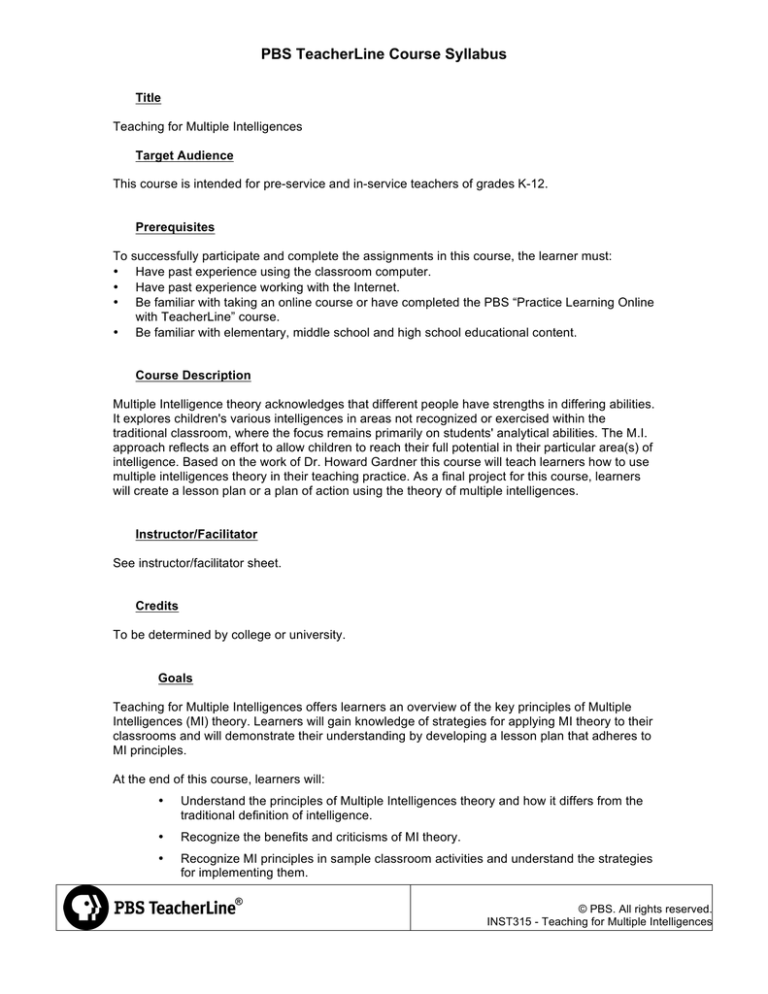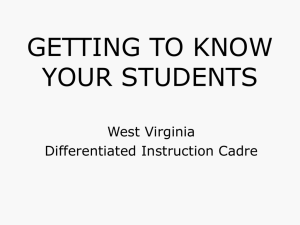
PBS TeacherLine Course Syllabus
Title
Teaching for Multiple Intelligences
Target Audience
This course is intended for pre-service and in-service teachers of grades K-12.
Prerequisites
To successfully participate and complete the assignments in this course, the learner must:
• Have past experience using the classroom computer.
• Have past experience working with the Internet.
• Be familiar with taking an online course or have completed the PBS “Practice Learning Online
with TeacherLine” course.
• Be familiar with elementary, middle school and high school educational content.
Course Description
Multiple Intelligence theory acknowledges that different people have strengths in differing abilities.
It explores children's various intelligences in areas not recognized or exercised within the
traditional classroom, where the focus remains primarily on students' analytical abilities. The M.I.
approach reflects an effort to allow children to reach their full potential in their particular area(s) of
intelligence. Based on the work of Dr. Howard Gardner this course will teach learners how to use
multiple intelligences theory in their teaching practice. As a final project for this course, learners
will create a lesson plan or a plan of action using the theory of multiple intelligences.
Instructor/Facilitator
See instructor/facilitator sheet.
Credits
To be determined by college or university.
Goals
Teaching for Multiple Intelligences offers learners an overview of the key principles of Multiple
Intelligences (MI) theory. Learners will gain knowledge of strategies for applying MI theory to their
classrooms and will demonstrate their understanding by developing a lesson plan that adheres to
MI principles.
At the end of this course, learners will:
•
Understand the principles of Multiple Intelligences theory and how it differs from the
traditional definition of intelligence.
•
Recognize the benefits and criticisms of MI theory.
•
Recognize MI principles in sample classroom activities and understand the strategies
for implementing them.
®
© PBS. All rights reserved.
INST315 - Teaching for Multiple Intelligences
PBS TeacherLine Course Syllabus
•
Apply the principles of the theory of Multiple Intelligences to a lesson plan.
•
Understand the ways technology can enhance the incorporation of MI principles into
classroom teaching.
•
Apply MI theory and strategies to classroom practice to engage more than one
intelligence to enhance understanding and improve student achievement.
Outline of Content and Assignments
After previewing the documents in the Course Information area, learners will proceed to Course
Content to complete the following six sessions, working through each session in order.
Throughout the sessions, learners are asked to articulate their ideas in various forms: they are
encouraged to reflect on their ideas and experiences in their online journal; the discussions in the
discussion forum are designed to allow learners to glean information from other learners’
experiences. As a final project, learners will develop a lesson plan based on the principles of
multiple intelligences. The lesson plan will be created and designed with emphasis on their
analysis of the activities they have completed and implemented in this course, as well as the
materials they reviewed for the course. They will post the lesson plan for peer review in Session 5
and finally, they will reflect on the lesson implementation.
This course is designed to address ISTE’s Educational Technology Standards and Performance
Indicators for All Teachers. These standards define the fundamental concepts, knowledge, skills,
and attitudes for applying technology in educational settings.
This course specifically addresses the following ISTE NETS*T:
I. Technology Operations and Concepts.
Teachers demonstrate a sound understanding of technology operations and concepts. Teachers:
A.
Demonstrate introductory knowledge, skills, and understanding of concepts related to
technology (as described in the ISTE National Education Technology Standards for Students).
II. Planning and Designing Learning Environments and Experiences.
Teachers plan and design effective learning environments and experiences supported by
technology. Teachers:
B. Apply current research on teaching and learning with technology when planning
learning environments and experiences.
III. Teaching, Learning, and the Curriculum.
Teachers implement curriculum plans that include methods and strategies for applying
technology to maximize student learning. Teachers:
B. Use technology to support learner-centered strategies that address the diverse
needs of students.
Visit cnets.iste.org for a full list of the ISTE’s Educational Technology Standards and Performance
Indicators for All Teachers and more information about these standards.
Session 1: The Theory of Multiple Intelligences
Do you ever notice times when you just "get it?" Or other times when your friend, spouse, or child
®
© PBS. All rights reserved.
INST315 - Teaching for Multiple Intelligences
PBS TeacherLine Course Syllabus
quickly grasps something that escapes you? This is a simplified way of thinking about the theory
of Multiple Intelligences. Dr. Howard Gardner, a prominent educational psychologist, came up
with this theory to explain why some people seem to grasp certain concepts or abilities quickly
and struggle with others. He also realized that by incorporating MI theory into the classroom, all of
a child's strengths are recognized, valued, and nurtured. Finally, many educators have used the
theory of multiple intelligences to adapt their instruction so it includes various intelligences in
order to help them meet the needs of all of their students.
Learners will begin this session by introducing themselves to fellow learners in the discussion
forum and by setting some goals. They will also jump right into the subject matter by creating
questions to guide their learning. Finally, they will learn about the nine intelligences and assess
their value for the classroom.
By the end of this session, learners will be able to:
• Define their professional goals and expectations for this course.
• Explain previous knowledge about the theory of multiple intelligences.
• Identify the intelligences that are not being addressed in their classroom.
• Explain how they would have to modify their teaching to include the intelligences that are
not being addressed in their classroom.
• Propose ways to apply the principles of multiple intelligences to their teaching practice.
Read
•
•
•
•
“Intelligences Defined”
“Frames of Mind” (introduction)
“Traditional versus Multiple Intelligences Theory”
“Learning Modalities: Pathways to Effective Learning” from PBS Teachers
View video
• “Kids’ Intelligences”
Complete assignment
st
• MI 1 Observation Assignment – learners will observe children and try to identify their
intelligence strengths.
Write in online journal
• Reflect on expectations for this course.
• Reflect on prior knowledge.
• Reflect on the following: “What kinds of intelligences do you think you are currently
not addressing in your classroom? How can you begin to include them?”
Participate in an online discussion
• Introduce themselves to other learners.
• Discuss the ways that principles of multiple intelligences can be integrated into the
classroom.
Session 2: Applications to Teaching and Learning
Now that learners are familiar with the basic concept of multiple intelligences, they may be
saying, 'Sure, it sounds good, but how do I actually apply it in the real world?' It might seem that
state and local mandates, parental expectations and the harsh realities of the daily school routine
make this loose definition of 'success' a far cry from the world they and their students' inhabit. In
this session, learners will see how the multiple intelligences theory has been applied to teaching
and learning. They will also learn some of the practical steps required to successfully integrate
®
© PBS. All rights reserved.
INST315 - Teaching for Multiple Intelligences
PBS TeacherLine Course Syllabus
the MI theory into a school setting.
By the end of the session, learners will be able to:
• Discuss different scenarios and strategies that incorporate MI principles to teach a given
unit in a classroom.
• Formulate ways their school might implement MI ideas in ways that support the school's
mission and goals.
• List and describe 5 different ways to incorporate MI strategies into their curriculum.
Read
•
•
"Multiple Intelligences in the Schools"
"Applying MI in Schools"
View video
• “I Love Sharks”
Explore
• “What’s my MI?” interactive
Complete Assignment
• Integration Assignment – learners will think of 5 ways to specifically integrate MI
theory into their lesson plans, activities, or assignments and post them in the
discussion forum. Learners can choose to present their ideas in a slideshow, video,
poster, or paper.
Write in online journal
• Reflect on their school's mission and goals, as well as on their own goals for their
students. In what ways could their school implement MI ideas in ways that support
those goals?
Participate in an online discussion
• Consider the list of intelligences addressed by various classroom activities: “How you
would add to, and interpret, the items on the list? For example, you can add more
intelligences and strategies, or you can give a scenario of how to use the above
strategies.”
Additional Resources (not required)
• “Creating Programs for Language Minority Families” from Colorín Colorado
• “Family Literacy Night” from Colorín Colorado
• Helping Your Child Succeed: Helpful PreK-12 Tips from Colorín Colorado
• Letter for Parents – Printable Archive from PBS Teachers
• “Understanding Children's Hearts and Minds: Emotional Functioning and Learning
Disabilities” from LD Online
Session 3: In the Classroom
We have all been challenged by a Jamie or Jamal or Jai who walks into our classrooms on the
first day of school with trouble in his/her eyes. At the ripe old age of nine, the desire to learn is
gone, some basic tools for success seem to be missing and there is no response, despite your
countless attempts at authentic overtures. By creating programs that truly engage multiple
intelligences, you might have a better shot at finding Jamie's strengths, and putting him/her back
in the game. In this session learners will look at various examples of using MI in the classroom to
observe best practices and determine what will work best for them and their students. They will
also begin to think about how technology can support the multiple intelligences theory. As they
®
© PBS. All rights reserved.
INST315 - Teaching for Multiple Intelligences
PBS TeacherLine Course Syllabus
proceed through this session, they should think about ways that technology supports and
encourages their own multiple intelligences and can also support and encourage their students'
various intelligences.
By the end of this session, learners will be able to:
• Describe how they would respond to using MI in their school.
• Evaluate how engaging in multimedia activities can exercise the various intelligence
areas and help students meet the standards.
Read
•
•
"MI, IT and Standards: The Story of Jaime"
“From All Sides Now”
View videos
• “Song”
• “Field Trip”
• “PSA”
Explore resources
• Hot Science: Interactive Archive from NOVA
• Secrets of the Dead: For Educators
• Everyday is Earth Day from Maya & Miguel
Visit Web sites:
• Annenberg/CPB Exhibits
• The Space Telescope Science Institute
• Active Learning Practice for Schools (ALPS)
• Eduscapes
Write in online journal
• Reflect on how multimedia projects and technology can be used to exercise the
various intelligence areas and help students meet the standards.
Participate in online discussion
• Discuss what sort of integration strategies could you incorporate to welcome the
opportunity to work with multiple intelligence theory?
Additional Resources (not required)
• Children and the Media from PBS Parents
• Get Your Web License from PBS Kids
Session 4: Implementation Strategies
With a general understanding of how MI theory can be used in a school setting, learners are
ready to begin working on their own MI lesson plans. While the thought of creating a lesson plan
that addresses all numerous intelligences might seem overwhelming, the reality is that learners
are probably incorporating a good number of the intelligences into their lesson plans already. The
lesson plans presented in this session, along with some of the readings, include charts, forms,
and rubrics that will help learners organize their thoughts. Assessing their own intelligences, as
well as their students' is a good place to start. As they create the first draft of their lesson plan,
they should work with their own strengths, as well as the strengths of their students. But also,
they should take the opportunity to branch out to additional intelligence areas.
®
© PBS. All rights reserved.
INST315 - Teaching for Multiple Intelligences
PBS TeacherLine Course Syllabus
By the end of this session, learners will be able to:
• Begin to design a lesson plan that incorporates MI principles.
• Discuss how they would have to modify an MI lesson plan to accommodate students'
different intelligences.
• Evaluate two MI teaching strategies and give an example of how technology might be
integrated into each of them.
Read
• “Curriculum Development through the Multiple Intelligences”
• "Salt Marsh" lesson plan
• "World Religions" lesson plan
• "Learning Centers Chart"
View video
• “Paintings”
• “Field Study Guide”
• “Music Intelligence”
Explore
• “Five Strategies” interactive
Complete assignments and activities
• Visit “Exploratorium” and “Virtual Frog Dissection” simulation Web sites
• Begin draft of Final Project: Lesson Plan
Write in online journal
• Reflect on the value of Learning Center and Simulation Activities for incorporating the
multiple intelligences using technology.
Participate in online discussion
• Choose one of the lesson plans and respond to the following: Is this approach
different from what you ordinarily would do and if so, how?
o How MI techniques enrich the learning experience.
o How MI techniques impact classroom practice.
o How you can adapt these techniques for your own classroom.
o How technology supports MI techniques.
Additional Resources (not required)
• “Adapting the Curriculum to Meet the Needs of Diverse Learners” from PBS
Teachers
• “How to Develop a Lesson Plan that Includes ELLs” from Colorín Colorado
• Attention: Responses from Misunderstood Minds
• Reading: Responses from Misunderstood Minds
• Writing: Responses from Misunderstood Minds
• Mathematics: Responses from Misunderstood Minds
Session 5: Assessment and MI
Perkins’, the author of the introductory quotation for this session (“Understanding is more a matter
of what people can DO than something they HAVE. Understanding involves action more than
possession,”) approach to understanding is especially relevant when creating MI assessment
tools. In much the same way that planning MI lessons encourages a wide range of activities, MI
®
© PBS. All rights reserved.
INST315 - Teaching for Multiple Intelligences
PBS TeacherLine Course Syllabus
assessment also incorporates a myriad of strategies, techniques and media to give students an
opportunity to express their understanding through a variety of intelligences. In this session,
learners will explore rubrics and other assessment examples that will help them create the
assessment component of their MI lesson plan.
By the end of the session, learners will be able to:
• Describe how an MI environment and assessment rubrics inspire students to achieve
higher results.
• Discuss how the MI rubrics and assessment strategies are different from others they
have used.
• Explain how assessment used in conjunction with MI principles should be different from
other forms of assessment.
• Reflect on the difference between observing and assessing the MI strengths of two
students.
Read
• “From All Sides Now”
• "Dissolving the Boundaries: Assessment That Enhances Learning”
• “Assessing Young Children”
Complete assignments and activities
• Post a draft of your MI lesson plan for peer review
• Complete a peer review for two other learners.
• MI 2nd Observation Assignment – learners will again observe the same two children
and create a reflection (written and/or multimedia) that reevaluates their original
analyses and describes the similarities and differences between their observations.
Write in online journal
• Reflect on rubrics used to assess the multiple intelligences.
Participate in online discussion
• Discuss the impact on teachers and students when working in an MI environment
and the value of assessment rubrics being presented at the outset of a lesson or
assignment.
Session 6: The MI Experience
In the past five sessions, learners acquired skills and information to enable them to implement MI
in the classroom, in their curriculum, and in their school. They will now review the work of their
peers, reflect on what they have learned, consider any questions they may still have, and
determine what their next steps will be for continuing to incorporate MI into their teaching
practice.
By the end of this session, learners will be able to:
• Evaluate the potential impact of implementing the MI culture in their classroom.
• Reflect on the process of implementing an MI a lesson in their classroom.
• Discuss the changes necessary to make their school into a model MI environment.
• Assess their learning in this course by comparing their prior knowledge and acquired
knowledge in a journal activity.
• Analyze the learning experience in this course by reflecting on their professional goals
and expectations.
®
© PBS. All rights reserved.
INST315 - Teaching for Multiple Intelligences
PBS TeacherLine Course Syllabus
Read
•
"The Key Learning Community"
Complete assignments and activities
• Revise and submit the Final Project: Lesson Plan.
• Reflection Assignment – learners will create a reflection that includes information on
the observation and implementation assignments, provides an analysis of future
implementation, an analysis of evaluation methods, and a reflection on using an MI
Approach. The reflection assignment can be in the form of a paper, video, or
slideshow.
Write in online journal
• Acquired knowledge
• Professional goals and expectations
Participate in an online discussion
• Discuss the changes necessary to make their school into a model MI environment,
such as the Key Learning Community.
Schedule
This course is scheduled to take approximately 30 hours. The number of hours identified for each
course reflects time spent online, but does not reflect the total time spent completing offline
coursework and assignments. All learners are different and learners will likely spend double the
indicated number of hours completing all coursework depending on learning styles and work
habits.
Requirements
Learners are expected to:
• Complete all assignments.
• Maintain an online journal.
• Participate and actively engage in discussions with fellow learners while contributing to
the social construction of knowledge.
• Be self-directed and self-motivated.
• Ask for assistance when they need it.
Materials (hardware, software, plug-ins)
Technical Requirements
• Word processor
• Internet service provider
• E-mail
Academic Dishonesty Policy
To be inserted by university institution only
Evaluation
®
© PBS. All rights reserved.
INST315 - Teaching for Multiple Intelligences
PBS TeacherLine Course Syllabus
This course is evaluated on a letter grade basis, and may be available for graduate credit. See
graduate credit details pertaining to specific graduate credit institutions.
®
© PBS. All rights reserved.
INST315 - Teaching for Multiple Intelligences



